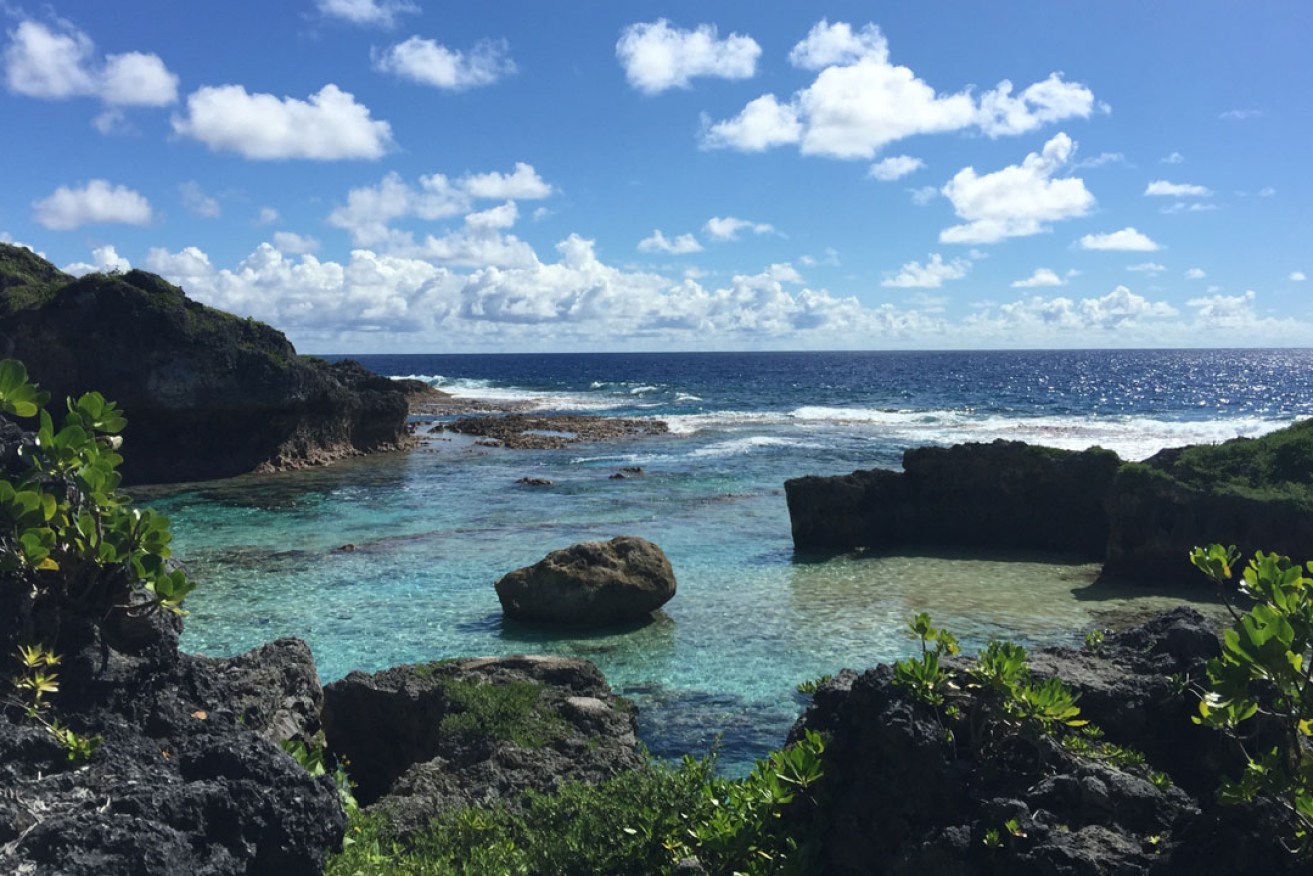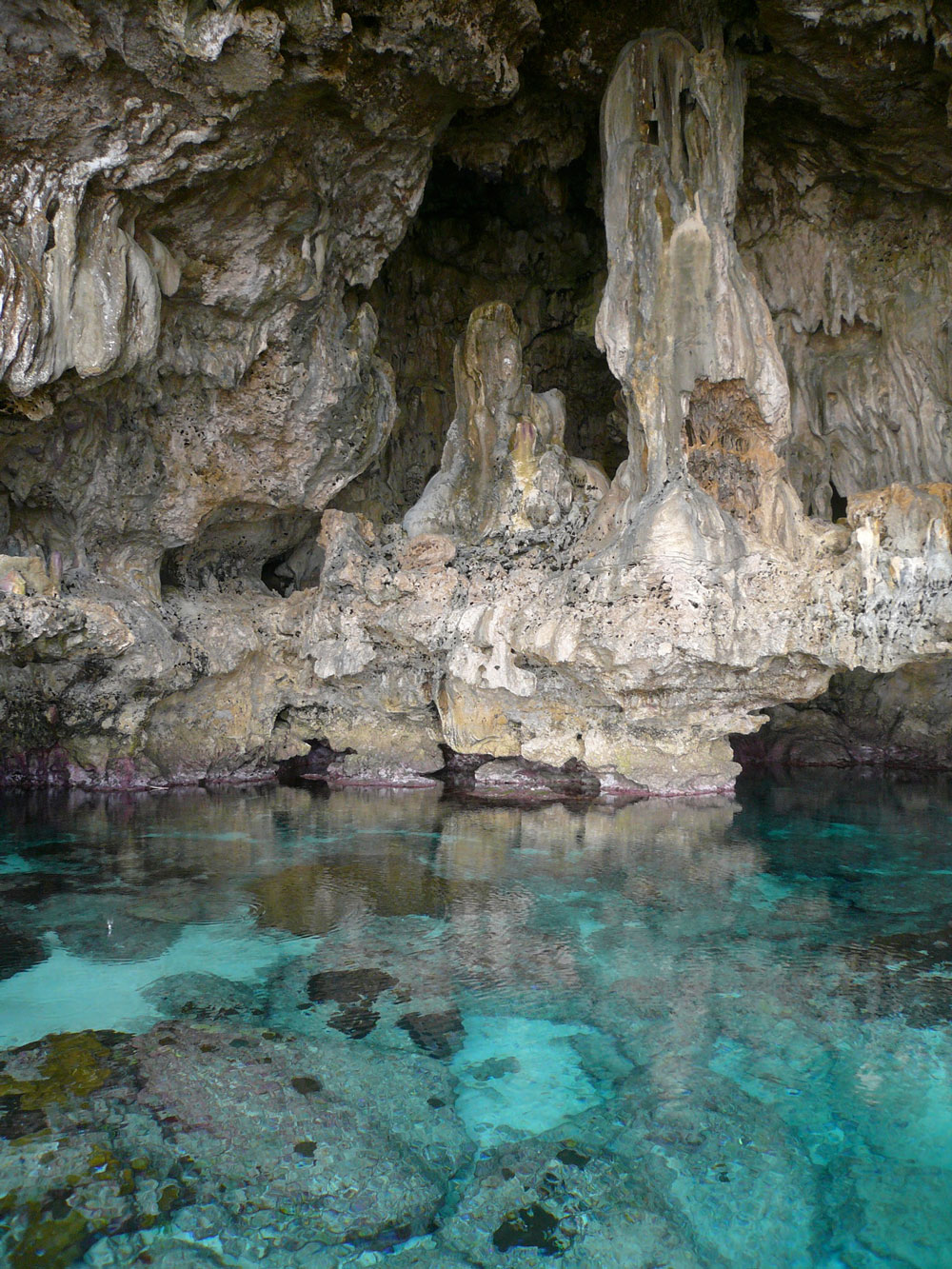Just you, a rock pool, and crabs for company
The South Pacific island of Niue may be virtually devoid of beaches but the adventurous can discover a secret Atlantean world of grottos, caves and astonishing natural pools with only crabs and guppies for company.

The Limu Pools on the north-east coast of Niue. Photo: Michael Wayne / AAP
A lift of the finger is all it takes. The lazy wave is returned in kind by the oncoming driver, and the transaction of politeness concludes. It took seconds, but it leaves me smiling … at least until the next car comes along.
That’s the etiquette of the road here in Niue, an island nation parenthesised by Fiji and the Cook Islands – and known for its manners. The waving is a must; the only times I’m not waved at are when it’s other tourists, or when I’m close to Alofi, the capital. Typical.
For holiday-makers looking for an island escape, Niue isn’t a name that rolls off the tongue. In fact, even for locals it doesn’t roll smoothly off the tongue. I’ve been here a day, and already I’ve heard about 400 interpretations, the most popular being NOO-WAY.
On paper, it’s unfortunate. In practice, it’s a musical, mysterious name for a destination that waits, in the heart of the South Pacific, for those with a sense of adventure and measured expectations.
I arrive on one of the two flights that fly here each week from Auckland, almost four hours away. Planes don’t arrive from anywhere else so both events draw small crowds.
“C’mon! It’s beautiful in here,” Terry, an ageing Kiwi, yells to Jean, his Canadian wife.
The Limu Pools are beautiful outside as well: deep, crystal-clear seawater swimming holes carved from rock over thousands of years and filled with the requisite aquarium of sea life to which the tropics are accustomed.
Terry’s day-glo bathers and pasty white skin stand out as the only blemish.
Jean, perched on a rock on the shore, rolls her eyes. “I know,” she calls to him, and then turns to me: “I’m not much of a swimmer.”
She pulls out a book. As Terry splashes about in the pool long ago reserved for Niuean royalty, Jean remains awkwardly perched on the rock, reading. It’s not a postcard image.
Anyone travelling to Niue with hopes of lounging around on pristine sandbars needs to adjust their expectations (or get a better travel agent).
Unlike just about every tropical island in the region, Niue is virtually devoid of beaches. An extinct volcano, Niue’s foundations are made up of dead, hardened coral. The two greatest consequences are the lack of beaches, and that it’s supremely difficult to grow vegetables.
On approach from the air, the absence creates a unique image. Without the white beaches you’d expect to see, the island looks like the Pacific’s missing jigsaw piece.
It’s a point of difference the country wears proudly on its sleeve.
“We’re so proud of what makes us unique among our South Pacific neighbours,” says Felicity Bollen, director of Niue Tourism.
“Fiji and Rarotonga have the beaches, but they don’t have the isolation or the sense of discovery. There’s nowhere like us.”
It’s true. All around the island, if you want to swim, you’ve got to earn it. It’s just as well, too: the Niuean forests and jungles will cause you to work up a sweat. There are no fences, no locked doors between you and the blue. Just that aggressive heat.

The crystal-clear water of Niue’s Avaiki Cave.
By the time I’ve hiked to Matapa Chasm in the island’s north, I’m soaked to the bone before I’ve even entered the water. Luckily for me, the chasm’s pool is refreshingly cold and shockingly clear – several neon fish zip away as I plunge into the water.
The natural formations around me are so conducive to aquatic frolicking you’d think they’d been planned. It’s only when you’re neck deep in a crisp cocktail of fresh and saltwater that it hits you: this is the result of the waves crashing against the coast, hour after hour, as they’ve done for millennia.
You’re in the Pacific’s swimming pool.
Niue’s lonely coastal road is peppered with sea tracks, long paths through the bush to the water’s edge. Some require a guide, others are self-serve, but all culminate in an Atlantean world of grottos, caves and astonishing natural pools.
An audience of crabs and guppies are treated to my one-man bathing show, and they show their appreciation by vanishing quickly.
The serenity of the pools reaches an apex at low tide, when Niue’s coral reefs are exposed enough to form a sea wall. It’s a peacefulness that’s juxtaposed with the constant pounding of the waves. Without beaches to ease them in, the Pacific’s fists slam into the rugged coastline with a natural violence.
The island’s ever-shrinking population (just below 2000 at last count) and placid tourism mean you’ll often find yourself alone at these spots. Much like Niue itself: the country stands alone in the vast South Pacific, with little to do with its more popular neighbours.
For the crabs and I, it’s a good thing. In our increasingly connected world, it’s still possible to get away from it all.
Getting there: Niue is approximately three and a half hours from Auckland. Air New Zealand flies to Hannan International Airport on Tuesdays and Fridays only.
Staying there: The island’s coast is spotted with motels and guesthouses, but accommodation is limited. The Scenic Matavai Resort is the most comfortable option. For more info visit scenichotelgroup.co.nz
Playing there: The sense of discovery and exploration of the unknown is enormous, but it helps to do some research. Visit niueisland.com for more info.
The writer was a guest of Niue Tourism and Air New Zealand.
-AAP




